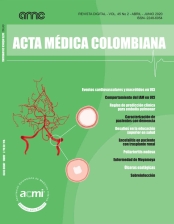Characterization of patients with early- vs. late-onset Alzheimer's Dementia
Abstract
Introduction: Alzheimer´s dementia (AD) has an early and a late onset. More information is needed regarding risk factors according to the age of onset of AD. The objective is to characterize the sociodemographic, anthropometric, laboratory and genetic variables as well as the history of patients with a de novo diagnosis of AD, by age of onset, at the Hospital Universitario C.A.R.I.´s mental health site over a period of two years.
Methods: a cross-sectional descriptive study of 39 patients with a de novo diagnosis of AD. A questionnaire was completed, paraclinical studies were ordered and a blood sample was obtained for APOE genotyping. The IBM SPSS 21 software was used for analysis.
Results: 82.05% had late-onset and 17.95% had early-onset AD. Of those with early-onset AD, 57.14% were females, as were 71.90% of those with late-onset AD. 71.44% of those with early-onset AD were married and 53.12% with late-onset AD were widowed. Only 14.29% with early-onset and 18.75% with late-onset AD had optimal LDL levels. Altogether, 79.49% of the population was heterozygous for the e4 allele. 71.43% of those with early-onset AD had a family history of dementia.
Discussion: age is the main factor associated with AD and females were more frequent in both groups. Social relationships play a role in early detection of symptoms. Lipid profile abnormalities were seen in both groups. Having at least one e4 allele is a frequent finding in AD. Having a firstdegree relative with dementia and/or Alzheimer´s was more frequent in early-onset AD.
Metrics
Copyright (c) 2020 Acta Médica Colombiana

This work is licensed under a Creative Commons Attribution 4.0 International License.
Acta Medica Colombiana uses the CC-BY 4.0 license. Authors retain all rights over their work.


